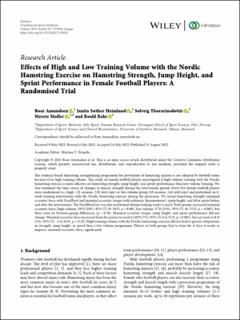| dc.contributor.author | Amundsen, Roar | |
| dc.contributor.author | Thorarinsdottir, Solveig | |
| dc.contributor.author | Møller, Merete | |
| dc.contributor.author | Bahr, Roald | |
| dc.contributor.author | Heimland, Janita Sæther | |
| dc.date.accessioned | 2022-12-01T10:07:05Z | |
| dc.date.available | 2022-12-01T10:07:05Z | |
| dc.date.created | 2022-10-19T14:54:09Z | |
| dc.date.issued | 2022 | |
| dc.identifier.citation | Translational Sports Medicine. 2022, Artikkel 7133928. | en_US |
| dc.identifier.issn | 2573-8488 | |
| dc.identifier.uri | https://hdl.handle.net/11250/3035258 | |
| dc.description | This is an open access article distributed under the Creative Commons Attribution License, which permits unrestricted use, distribution, and reproduction in any medium, provided the original work is properly cited. | en_US |
| dc.description.abstract | The evidence-based hamstring strengthening programme for prevention of hamstring injuries is not adopted by football teams because of its high training volume. This study on female football players investigated if high-volume training with the Nordic hamstring exercise is more effective on hamstring strength, jump height, and sprint performance than low-volume training. We also examined the time course of changes in muscle strength during the intervention period. Forty-five female football players were randomised to a high- (21 sessions, 538 total reps) or low-volume group (10 sessions, 144 total reps) and performed an 8-week training intervention with the Nordic hamstring exercise during the preseason. We tested hamstring strength (maximal eccentric force with NordBord and maximal eccentric torque with isokinetic dynamometer), jump height, and 40 m sprint before and after the intervention. The NordBord test was also performed during training weeks 4 and 6. Both groups increased maximal eccentric force (high-volume: 29 N (10%), 95% CI: 19–38 N, p < 0.001, low-volume: 37 N (13%), 95% CI: 18–55 N, p = 0.001), but there were no between-group differences (p = 0.38). Maximal eccentric torque, jump height, and sprint performance did not change. Maximal eccentric force increased from the pretest to week 6 (20 N (7%), 95% CI: 8 to 31 N, p < 0.001), but not week 4 (8 N (3%), 95% CI: −2 to 18 N, p = 0.22). High training volume with the Nordic hamstrings exercise did not lead to greater adaptations in strength, jump height, or speed than a low-volume programme. Players in both groups had to train for at least 6 weeks to improve maximal eccentric force significantly. | en_US |
| dc.language.iso | eng | en_US |
| dc.subject | exercise | en_US |
| dc.subject | female | en_US |
| dc.subject | female football | en_US |
| dc.subject | football | en_US |
| dc.subject | hamstring | en_US |
| dc.subject | injuries | en_US |
| dc.subject | jump height | en_US |
| dc.subject | muscle strength | en_US |
| dc.subject | performance | en_US |
| dc.subject | sprint | en_US |
| dc.subject | training volume | en_US |
| dc.title | Effects of high and low training volume with the Nordic hamstring exercise on hamstring strength, jump height, and sprint performance in female football players: A randomised trial | en_US |
| dc.type | Peer reviewed | en_US |
| dc.type | Journal article | en_US |
| dc.description.version | publishedVersion | en_US |
| dc.rights.holder | © 2022 Roar Amundsen et al. | en_US |
| dc.source.pagenumber | 9 | en_US |
| dc.source.journal | Translational Sports Medicine | en_US |
| dc.identifier.doi | 10.1155/2022/7133928 | |
| dc.identifier.cristin | 2062894 | |
| dc.description.localcode | Institutt for idrettsmedisinske fag / Department of Sports Medicine | en_US |
| dc.source.articlenumber | 7133928 | en_US |
| cristin.ispublished | true | |
| cristin.fulltext | original | |
| cristin.qualitycode | 1 | |
